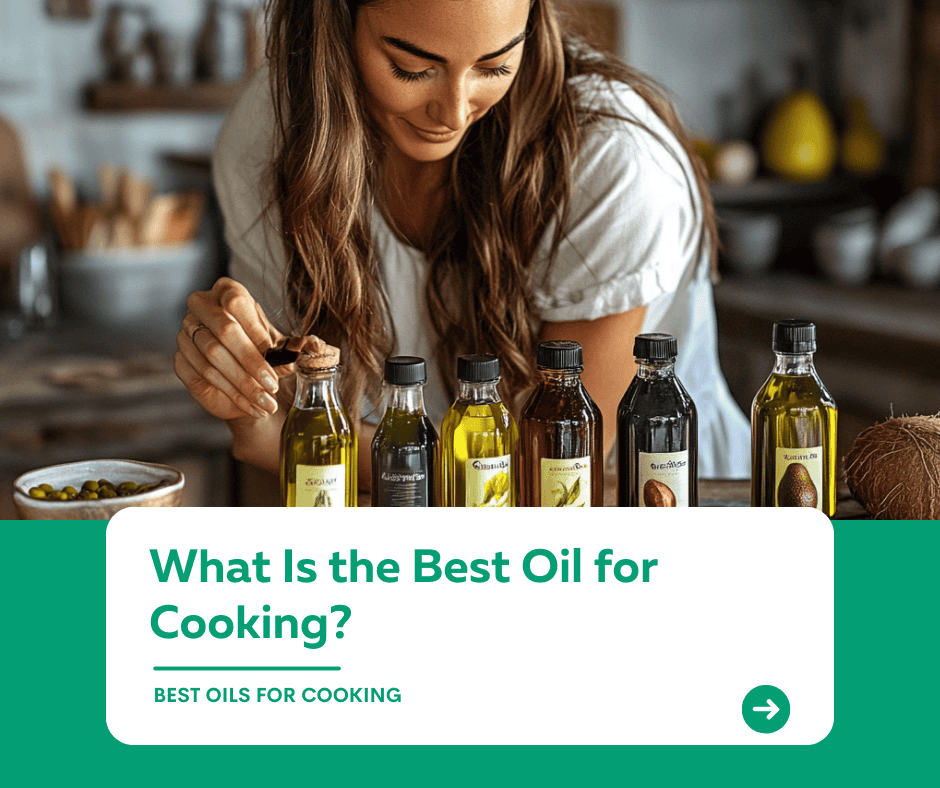What Is the Best Oil for Cooking? A Guide to Choosing the Right Oil ?

Introduction
“What is the best oil for cooking?” With so many options available—each with unique properties and uses—choosing the right oil for your dish can be overwhelming. Oils differ in flavor, health benefits, and smoke points, making certain types better suited for specific cooking techniques. This guide will help you understand the different kinds of cooking oils and how to choose the right one based on your health goals and cooking needs.
For more kitchen tips and guides, explore kuestion.co.
1. Understanding Smoke Point and Why It Matters
The smoke point of an oil is the temperature at which it begins to smoke and break down. When an oil reaches its smoke point, it releases free radicals and develops an unpleasant taste, impacting the quality and nutritional value of your dish. Choosing oils with appropriate smoke points ensures better flavor and safer cooking.
For example:
- High-smoke-point oils (over 400°F), such as avocado and grapeseed oil, are ideal for high-heat cooking techniques like frying and grilling.
- Medium-smoke-point oils (300-400°F), like olive oil and coconut oil, work well for sautéing and baking.
- Low-smoke-point oils (below 300°F), such as extra virgin olive oil and flaxseed oil, are best used for dressings and drizzling.
2. The Health Aspect: Saturated vs. Unsaturated Fats
The nutritional value of cooking oils largely depends on their fat content. Oils can be primarily categorized into:
- Saturated fats: These fats are generally solid at room temperature and found in oils like coconut oil and palm oil. While some saturated fats, like those in coconut oil, can add flavor, they should be used in moderation due to their association with higher cholesterol levels.
- Unsaturated fats: Found in oils like olive, avocado, and canola oil, unsaturated fats (both monounsaturated and polyunsaturated) are generally regarded as heart-healthy fats.
Oils rich in unsaturated fats, especially monounsaturated fats like olive and avocado oil, are often preferred for regular cooking. Studies have shown that using unsaturated oils in place of saturated ones can help reduce the risk of heart disease and promote better health.
For more insights into healthy cooking tips, check out kuestion.co.
3. Popular Cooking Oils and Their Uses
Olive Oil
- Uses: Olive oil is versatile and rich in antioxidants. It has a medium smoke point, making it suitable for sautéing, baking, and even drizzling over salads.
- Benefits: High in monounsaturated fats, extra virgin olive oil is known for its heart-healthy benefits. It has a robust flavor, which enhances Mediterranean and Italian dishes.
Avocado Oil
- Uses: Avocado oil has one of the highest smoke points (over 500°F), making it excellent for grilling, frying, and roasting. Its mild flavor allows it to blend well with various ingredients.
- Benefits: Avocado oil is rich in monounsaturated fats and vitamin E, supporting skin health and heart health. Its neutral flavor makes it a favorite for high-heat cooking.
Canola Oil
- Uses: Affordable and versatile, canola oil is a good choice for frying, baking, and general cooking. With a smoke point of around 400°F, it can handle a variety of dishes.
- Benefits: Canola oil is low in saturated fats and high in omega-3 fatty acids, making it a healthier option for everyday cooking. Its mild taste keeps it unobtrusive in recipes.
Coconut Oil
- Uses: With a medium smoke point, coconut oil is ideal for sautéing and baking. Its unique flavor adds a hint of coconut to dishes, which can complement certain cuisines.
- Benefits: While coconut oil contains saturated fats, it also offers MCTs (medium-chain triglycerides), which are easier for the body to break down. Use in moderation for occasional cooking.
Grapeseed Oil
- Uses: Grapeseed oil is a high-smoke-point oil that’s ideal for frying, roasting, and baking. Its light, neutral flavor doesn’t overpower dishes.
- Benefits: Known for its vitamin E content, grapeseed oil is often used in health-conscious recipes. It also contains polyunsaturated fats that can support heart health.
4. Matching Oils to Cooking Techniques
Choosing the right oil can significantly impact the flavor and quality of your dish. Here’s a quick guide to matching oils with cooking techniques:
- Frying and High-Heat Cooking: Use oils with high smoke points, such as avocado, peanut, or grapeseed oil, to prevent the oil from breaking down.
- Sautéing and Medium-Heat Cooking: Olive oil and coconut oil work well for medium-heat applications, adding flavor without reaching their smoke point.
- Dressings and Finishing Oils: Extra virgin olive oil, walnut oil, and flaxseed oil are best for dressings or drizzling over finished dishes, adding rich flavor without needing heat.
For more on choosing the right cooking oils, visit kuestion.co.
5. Tips for Storing and Using Cooking Oils
To get the best flavor and longevity out of your cooking oils, proper storage and usage are essential.
- Store in a Cool, Dark Place: Light and heat can degrade oils, causing them to go rancid. Keep oils in a cool cupboard away from the stove.
- Check Expiration Dates: Oils have a limited shelf life, typically 6-12 months. If an oil smells off or has a strange taste, it’s best to discard it.
- Use a Dark Glass or Metal Container: Oils stored in dark glass or opaque containers are better protected from light, which helps retain freshness.
Oils like olive and avocado oil can be stored in the fridge to prolong freshness, but oils that solidify at low temperatures, such as coconut oil, can be kept at room temperature.
6. Experimenting with Flavored Oils
Flavored oils can add unique, complex notes to your dishes without additional ingredients. Try garlic-infused olive oil for pasta, or chili-infused oil for stir-fries. Flavored oils are best used as finishing oils for added aroma and taste. You can even create your own flavored oils by adding herbs, garlic, or spices to a base oil.
Conclusion
Choosing the best cooking oil depends on your cooking technique, health goals, and flavor preferences. With options like olive, avocado, and grapeseed oil, you can explore different tastes and benefits in your cooking. Remember to consider the smoke point, health benefits, and cooking method to find the perfect match.
For more kitchen guides, tips, and answers to common cooking questions, visit kuestion.co.




